The Intel Core i3-13100F Review: Finding Value in Intel's Cheapest Core Chip
by Gavin Bonshor on April 20, 2023 9:00 AM ESTCPU Benchmark Performance: Power And Office
Our previous sets of ‘office’ benchmarks have often been a mix of science and synthetics, so this time we wanted to keep our office section purely on real-world performance. We've also incorporated our power testing into this section too.
The biggest update to our Office-focused tests for 2023 and beyond include UL's Procyon software, which is the successor to PCMark. Procyon benchmarks office performance using Microsoft Office applications, as well as Adobe's Photoshop/Lightroom photo editing software, and Adobe Premier Pro's video editing capabilities. Due to issues with UL Procyon and the video editing test, we haven't been able to properly run these, but once we identify a fix with UL, we will re-test each chip.
We are using DDR5-4800 memory on the Intel Core i3-13100F as per the JEDEC specifications. Other recent chips, such as Intel's 13th/12th Gen Core series and Ryzen 7000 processors, are also tested at the rated JEDEC specifications. We tested the aforementioned platforms with the following settings:
- DDR5-5600B CL46 - Intel 13th Gen
- DDR5-5200 CL44 - Ryzen 7000
- DDR5-4800 (B) CL40 - Intel 12th Gen
- DDR5-4800 (B) CL40 - Intel 13th Gen Core i3 series
All other CPUs such as Ryzen 5000 and 3000 were tested at the relevant JEDEC settings as per the processor's individual memory support with DDR4.
Power
The nature of reporting processor power consumption has become, in part, a bit of a nightmare. Historically the peak power consumption of a processor, as purchased, is given by its Thermal Design Power (TDP, or PL1). For many markets, such as embedded processors, that value of TDP still signifies the peak power consumption. For the processors we test at AnandTech, either desktop, notebook, or enterprise, this is not always the case.
Modern high-performance processors implement a feature called Turbo. This allows, usually for a limited time, a processor to go beyond its rated frequency. Exactly how far the processor goes depends on a few factors, such as the Turbo Power Limit (PL2), whether the peak frequency is hard coded, the thermals, and the power delivery. Turbo can sometimes be very aggressive, allowing power values 2.5x above the rated TDP.
AMD and Intel have different definitions for TDP that are, broadly speaking, applied the same. The difference comes from turbo modes, turbo limits, turbo budgets, and how the processors manage that power balance. These topics are 10000-12000 word articles in their own right, and we’ve got a few articles worth reading on the topic.
- Why Intel Processors Draw More Power Than Expected: TDP and Turbo Explained
- Talking TDP, Turbo and Overclocking: An Interview with Intel Fellow Guy Therien
- Reaching for Turbo: Aligning Perception with AMD’s Frequency Metrics
- Intel’s TDP Shenanigans Hurts Everyone
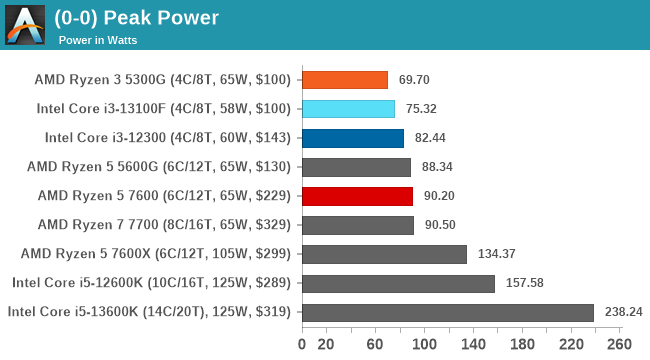
Looking at the peak power values for all of the sub $350 CPUs we've tested with the latest CPU suite, the Core i3-13100F, as expected draws the least power overall. The difference between the Core i3-13100F and the Core i3-12300 is around 7 W, which isn't massive, especially given they have the same Intel Golden Cove performance cores.
Diving into the power consumption of the Core i3-13100F during a Prime95 sustained load, we found that power was delivered consistently between 72 and 75 W, with no drop in frequency and power unless the compute load itself dropped off. This means that peak power is delivered for the duration when at full load. It also shows that Intel's Core i3-13100F is performing well within the associated turbo TDP power limit of 89 W.
Office/Web
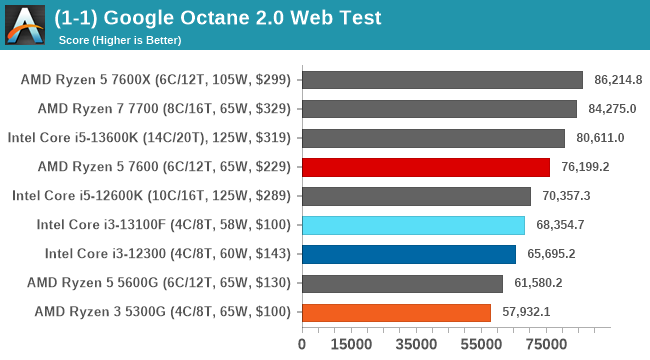
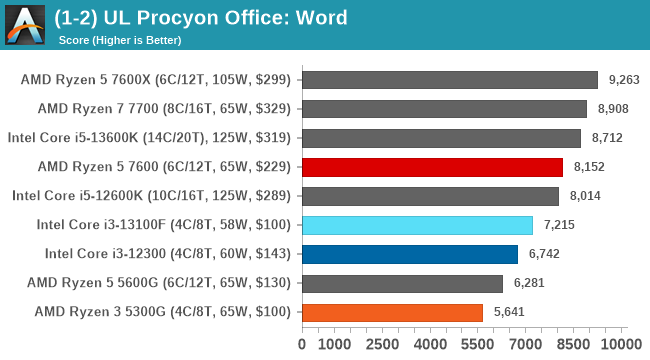
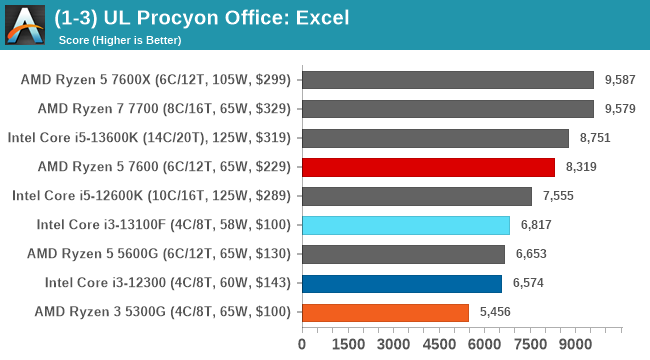

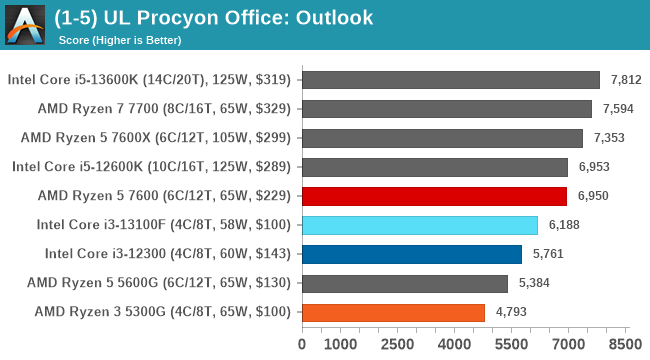
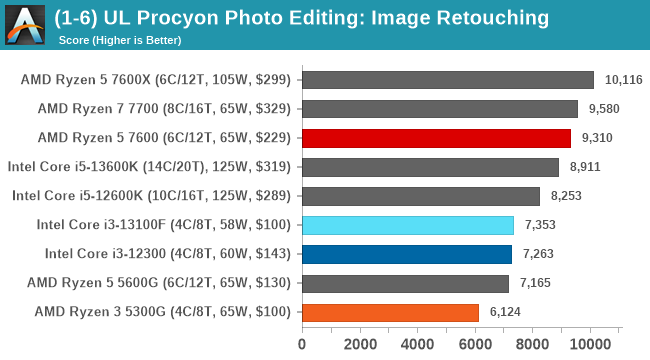
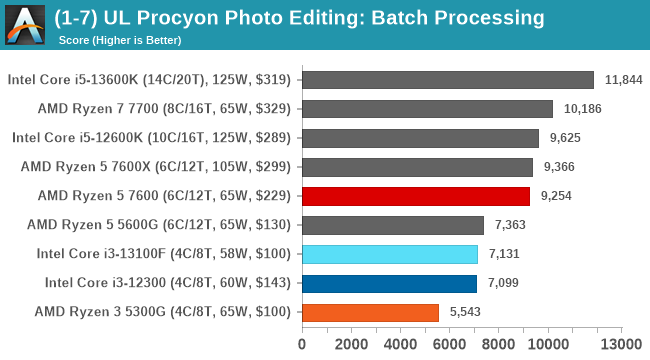

In office and productivity based benchmarks, the Core i3-13100F does very well considering it's a quad-core chip pitted up against six, eight, and even the Core i5-13600K, which is a 14C/20T part. As expected, the Core i3-13100F is slightly better than the Core i3-12300 as it has slightly faster cores.
Comparing Intel's latest quad-core to AMD's most recent quad-core, Intel has a distinct advantage in IPC performance as it's a newer process (Raptor/Alder Lake versus Zen 3) and clock speeds.











34 Comments
View All Comments
porina - Thursday, April 20, 2023 - link
"Kaby Lake family of parts (8th Gen Core)" 8th gen was Coffee Lake.Interesting overall. I'd consider 6 core as entry level for anything other than the most basic tasks and 8 isn't that much a stretch.
Ryan Smith - Thursday, April 20, 2023 - link
Ahh, you're right. We got Kaby, and then Coffee, and then Coffee again. Thanks!adamxpeter - Thursday, April 20, 2023 - link
"but for an MSRP of $109 and a current selling price of $100 at Amazon" - then why $119 on the diagrams?Gavin Bonshor - Friday, April 21, 2023 - link
Thank you for pointing this out. I've changed it. When I made the graphs, that was the price, and I just forgot to update it.nrencoret - Thursday, April 20, 2023 - link
Although I like the article, I think the value comes in the form of the 5600g. I think the author should have focused attention not on the R7 but on the 5600. 20/30 USD for a more complete package seems to me like a better price/performance competitor.dwillmore - Friday, April 21, 2023 - link
That was my takeaway as well. It seemed odd to pick the F version of the 13th gen chip when everything else in the price segment had graphics. It seems an unfair bias against all of the other chips.If I was looking at a machine in this range, I'd certainly look at the 5600G. Fortunately, I am not, I just retired a 3700X to my kids PC.
lightningz71 - Thursday, April 20, 2023 - link
Why, oh why, are we pitting a 13100F against the 5300g? If you are dredging the bottom of the barrel, you need to look at the Ryzen 5500, which is going for $96 at amazon right now. It has NO video, matching the 13100f, has TWO more cores, and a higher boost than the 5300g. The two additional cores significantly extend it's useful life and opens higher end, more modern games to the user. It can go on any of the AM4 boards easily as well. In addition, having TWICE the L3 cache of the 5300g makes a notable impact on many titles. Yes, I doubt it wins in single threaded benchmarks, but in practicle use, its likely an overall netter choice!Ryan Smith - Friday, April 21, 2023 - link
Picking the competition for low-end chips is always a bit of a challenge due to the sheer number of options. There's the last-gen stuff, the current-gen stuff, the higher-tier last-gen stuff that's had price cuts, random SKUs that may or may not have received permanent price cuts, etc. And of course, what chips we have on hand, since AMD and Intel don't sample their complete product stacks.We opted to focus on the true low-end parts, in part because that's what we have available, and because I'm not convinced a $99 chiplet Ryzen is going to hang around. But you're definitely correct that there are additional comparisons we could have made.
DirtyLoad - Wednesday, April 26, 2023 - link
Hi Ryan,I like the article, but the better chip to compare is the 5600. It has double the L3 of the 5600g, which is just a 5500 with graphics. Wouldn't the extra cache help on some games/programs.
Samus - Sunday, April 23, 2023 - link
I would argue the 'practical' use these budget chips target greatly benefit from stronger, not more cores, and Intel wins that department when comparing Zen3 Ryzen 5xxx parts to 12\13 gen.